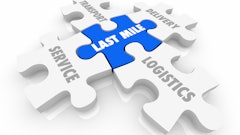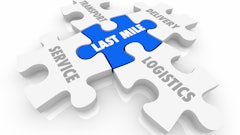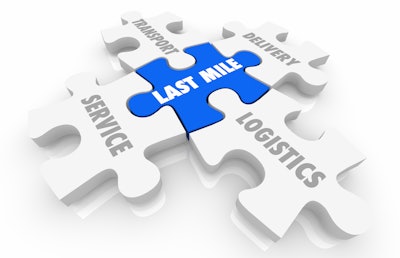
In recent years, supply chains have grown more and more complicated, primarily fueled by a rise in disruption, customer expectations, and sustainability demands. Given the ever-changing industry landscape, businesses must find solutions to adhere to this new environment, while still maintaining profitability and customer satisfaction.
While it’s impossible to make these pivots overnight, it begins with optimizing logistics, especially when it comes to the final – but critical – piece of the supply chain puzzle: the last mile. When a company has an efficient last-mile strategy, they will be able to do the following.
Overcome unexpected disruptions
Disruptions can occur at any point within the supply chain cycle, making proper planning key to any logistics strategy. Disruptions in the last mile, such as traffic or inefficient routes, can introduce roadblocks ahead of delivery. Optimizing final-mile logistics with a transportation management system (TMS) can help alleviate these challenges in a few ways:
1. Real-time routing. TMS provides routing that actively monitors traffic patterns to present the most efficient route. This helps avoid common last mile disruptions, such as time wasted in traffic.
2. Live driver tracking. Real-time driver tracking provides updates to the back office, allowing businesses to proactively manage service disruption if one is projected to happen.
3. Alternative vehicle recommendations. With visibility over the entire final mile journey, TMS can evaluate the best modes of transportation to complete the delivery efficiently. For example, utilizing vehicles like scooters in more densely populated areas may help facilitate faster throughput.
Though disruption is difficult to predict, the ability to plan efficient routes based on historical data, track drivers in real-time, and pivot to alternative delivery methods makes operations more flexible and adaptable.
Improve customer satisfaction
Customer demands are constantly changing and today, many crave a high level of visibility into their delivery process. In fact, according to a recent survey from Körber Supply Chain Software, 86% of consumers use apps/websites to track their packages as they are in transit, with the majority (45%) tracking their packages once daily until arrival and a third (33%) checking more than once a day.
With access to specific delivery routes, traffic patterns, and live driver tracking, businesses can pass on in-depth insight to customers, providing the real-time visibility they desire. Also, it helps businesses proactively communicate delays, which in turn, fosters brand loyalty, even if an issue arises.
In addition to visibility, it’s no secret that customers are looking for same or next day shipping, which can be a costly feat. However, companies can rework their last-mile strategies to partner with local distribution centers, making routes more efficient and improving the stop-to-driver ratio – ultimately, making fast delivery possible.
But the customer experience doesn’t end once the delivery is made. Consumers are now expecting more when it comes to returns, or reverse logistics, looking for the process to be convenient, but also free. With an average retail return rate of 26.4% for e-commerce purchases, they are notoriously disruptive to the final mile process and if poorly managed, they can severely impact customer satisfaction. Luckily, businesses can alleviate these burdens with last mile optimization, making reverse logistics a part of their day-to-day route planning and delivery management.
Meet sustainability goals
The environment is top-of-mind for businesses and customers alike. Though getting the product to the end consumer as quickly as possible is important, many consumers also consider sustainable business practices when choosing which companies to shop from. Specifically, the survey found that 40% of consumers choose where to shop based on the brand’s commitment to sustainability.
Beyond meeting customer expectations for sustainability, companies also have their own sustainability goals they are marching toward. With the help of TMS, routes can be efficiently planned to cut down on mileage, time spent in traffic and more, lowering companies’ CO2 emissions as a whole.
Optimization tools can also push businesses to proactively look at alternative, highly sustainable delivery options via offering “what if” scenarios. For example, what if electric vehicles, drones, scooters and other smaller delivery vehicles can be more operationally sustainable. With the number of environmentally friendly options on the market, it’s always important for companies to consider making strategic shifts.
Success in the last mile
No process can be refined and perfected without diligent measurement and metric tracking. When looking specifically at the last mile, the most important measurements of success include customer satisfaction, cost reduction, and lower CO2 emissions. However, it doesn’t stop there.
It’s also vital to look at more nuanced figures, like on-time service, missed appointments, total cost per package handled, and mile totals. In looking at each aspect of the delivery process, rather than just measuring if the package got to its destination, businesses will be able to further optimize their last mile strategy to not only meet goals but exceed them.
For example, one retail customer who provides white-glove furniture delivery services was able to measure success in their last-mile operations in several ways. First, they were able to improve customer satisfaction scores by focusing on on-time delivery with fewer missed appointments and backhauling their packaging material. In addition, they were able to provide customers with multiple delivery window options that were operationally efficient for the business as well. Improving the efficiency of last-mile delivery leads to undeniably positive business outcomes, now and in the future.
Looking ahead: The future of last-mile logistics
As the world constantly changes, companies will continue to embrace new technologies to further master the art of last-mile logistics. Specifically, as AI continues to become more integrated into day-to-day business and logistics strategies, AI supported optimization is going to allow for further improvements to route planning, parcel tracking, and more.
![Pros To Know 2026 [color]](https://img.sdcexec.com/mindful/acbm/workspaces/default/uploads/2025/08/prostoknow-2026-color.mduFvhpgMk.png?auto=format%2Ccompress&bg=fff&fill-color=fff&fit=fill&h=100&q=70&w=100)




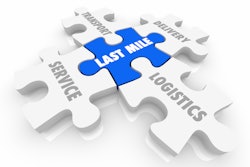

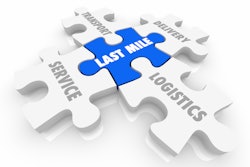

![Pros To Know 2026 [color]](https://img.sdcexec.com/mindful/acbm/workspaces/default/uploads/2025/08/prostoknow-2026-color.mduFvhpgMk.png?ar=16%3A9&auto=format%2Ccompress&bg=fff&fill-color=fff&fit=fill&h=135&q=70&w=240)






